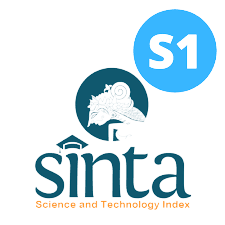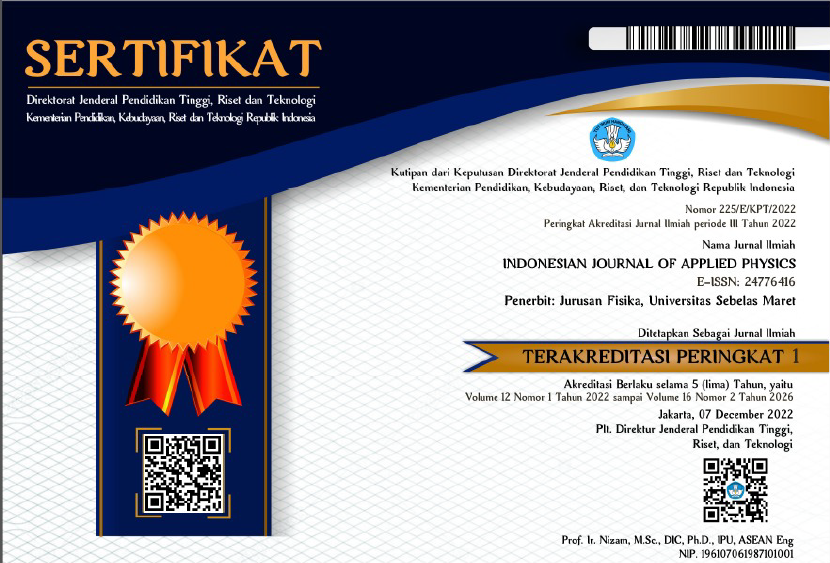The Combined Boris-Cyclotronic Integrator for Axially Symmetric Penning Ion Source Simulation
Abstract
An investigation of the use of combined boris-cyclotronic particle integrator scheme for 2D axially symmetric Penning ion source simulation program has been performed. The particle-in-cell based simulation program was intended to be used for Penning ion source optimization. The combination was done by using cyclotronic integrator in cylindrical coordinates while ions were integrated using Boris algorithm (Boris-Cyclotronic scheme). The investigation was centered around the claim that cyclotronic integrator is not limited by gyration period constraints, unlike Boris algorithm. As a benchmark, this scheme is compared against the standard approach in which both species are integrated using the Boris algorithm (All-Boris scheme). The plasma sustainability result shows that for regions where time step width is smaller than the gyration period, Boris-Cyclotronic algorithm is indistinguishable from All-Boris algorithm. For time step width comparable to gyration period, there is an increase in electron production in Boris-Cyclotronic algorithm while All-Boris algorithm remains the same. Single-particle tests show that although the Boris integrator produces noisy trajectories, it maintains a bounded energy error and a consistent average path. In contrast, the cyclotronic integrator produces smoother trajectories but introduces significant oscillatory energy gain, which leads to artificial ionization and exaggerated electron production. These findings indicate that despite its less accurate individual trajectories, the All-Boris scheme provides more physically consistent results for Penning ion source simulation than the Boris–Cyclotronic scheme
Keywords
Full Text:
PDFReferences
1 Taufik, Hermanto, A., Anggraita, P., & Santosa, S. 2014. Determination of magnet specification of 13 MeV proton cyclotron based on opera 3D. Atom Indonesia, 40(2), 69–75.
2 Silakhuddin, S., Darmawan, R. S., Suharni, S., Permana, F. S., Wibowo, K., Saminto, S., & Atmono, T. 2018. Ion beam preliminary testing of DECY-13 cyclotron at the central region using dc extraction voltage. IOP Conference Series: Materials Science and Engineering, 432(1).
3 Jacobson, O., Kiesewetter, D. O., & Chen, X. 2015. Fluorine-18 radiochemistry, labeling strategies and synthetic routes. Bioconjugate Chemistry, 26(1), 1–18.
4 Yeon, Y. H., Ghergherehchi, M., Mu, X., Gad, K. M. M., & Chai, J. S. 2014. Development and discharge characteristics of negative hydrogen ion source for the SKKUCY-9 cyclotron. Nuclear Instruments and Methods in Physics Research, Section A: Accelerators, Spectrometers, Detectors and Associated Equipment, 763, 510–516.
5 Bacal, M., & Wada, M. 2015. Negative hydrogen ion production mechanisms. Applied Physics Reviews, 2(2).
6 Birdsall, C. K. 1991. Particle-in-Cell Charged-Particle Simulations, Plus Monte Carlo Collisions With Neutral Atoms, PIC-MCC. IEEE Transactions on Plasma Science, 19(2), 65–85.
7 Ripperda, B., Bacchini, F., Teunissen, J., Xia, C., Porth, O., Sironi, L., Lapenta, G., & Keppens, R. 2018. A Comprehensive Comparison of Relativistic Particle Integrators. The Astrophysical Journal Supplement Series, 235(1), 21.
8 Juhasz, Z., Ďurian, J., Derzsi, A., Matejčík, Š., Donkó, Z., & Hartmann, P. 2021. Efficient GPU implementation of the Particle-in-Cell/Monte-Carlo collisions method for 1D simulation of low-pressure capacitively coupled plasmas. Computer Physics Communications, 263, 107913.
9 Langdon, A. B. 2014. Evolution of particle-in-cell plasma simulation. IEEE Transactions on Plasma Science, 42(5), 1317–1320.
10 Zenitani, S., & Kato, T. N. 2020. Multiple Boris integrators for particle-in-cell simulation. Computer Physics Communications, 247(xxxx), 106954.
11 Qin, H., Zhang, S., Xiao, J., Liu, J., Sun, Y., & Tang, W. M. 2013. Why is Boris algorithm so good? Physics of Plasmas, 20(8), 084503.
12 Patacchini, L., & Hutchinson, I. H. 2009. Explicit time-reversible orbit integration in Particle In Cell codes with static homogeneous magnetic field. Journal of Computational Physics, 228(7), 2604–2615.
13 Rafieian Najaf Abadi, M., Mahjour-Shafiei, M., & Yarmohammadi Satri, M. 2018. Simulation and optimization of a negative hydrogen Penning ion source. Physics of Plasmas, 25(12).
14 Tao, M. 2016. Explicit high-order symplectic integrators for charged particles in general electromagnetic fields. Journal of Computational Physics, 327(September), 245–251.
15 He, Y., Sun, Y., Liu, J., & Qin, H. 2016. Higher order volume-preserving schemes for charged particle dynamics. Journal of Computational Physics, 305, 172–184.
16 Fubiani, G., & Boeuf, J. P. 2013. Role of positive ions on the surface production of negative ions in a fusion plasma reactor type negative ion source - Insights from a three dimensional particle-in-cell Monte Carlo collisions model. Physics of Plasmas, 20(11).
17 Fubiani, G., & Boeuf, J. P. 2015. Three-dimensional modeling of a negative ion source with a magnetic filter: Impact of biasing the plasma electrode on the plasma asymmetry. Plasma Sources Science and Technology, 24(5), 55001.
18 Taccogna, F., & Minelli, P. 2017. PIC modeling of negative ion sources for fusion. New Journal of Physics, 19(1).
19 Taccogna, F. 2015. Monte Carlo Collision method for low temperature plasma simulation. Journal of Plasma Physics, 81(1).
20 20. Brieda, L. 2019. Plasma Simulations by Example. In Plasma Simulations by Example. CRC Press.
21 Delzanno, G. L., & Camporeale, E. (2013). On particle movers in cylindrical geometry for Particle-In-Cell simulations. Journal of Computational Physics, 253, 259–277.
22 Zenitani, S., & Umeda, T. (2018). On the Boris solver in particle-in-cell simulation. Physics of Plasmas, 25(11).
23 Knapp, C., Kendl, A., Koskela, A., & Ostermann, A. 2015. Splitting methods for time integration of trajectories in combined electric and magnetic fields. Physical Review E - Statistical, Nonlinear, and Soft Matter Physics, 92(6), 1–13.
24 Yu, S., Wu, H., Xu, J., Wang, Y., Gao, J., Wang, Z., Jiang, W., & Zhang, Y. 2023. A generalized external circuit model for electrostatic particle-in-cell simulations. Computer Physics Communications, 282, 108468.
25 Itikawa, Y. 1974. Momentum-transfer cross sections for electron collisions with atoms and molecules. Atomic Data and Nuclear Data Tables, 14(1), 1–10.
26 Yoon, J. S., Song, M. Y., Han, J. M., Hwang, S. H., Chang, W. S., Lee, B., & Itikawa, Y. 2008. Cross sections for electron collisions with hydrogen molecules. Journal of Physical and Chemical Reference Data, 37(2), 913–931.
Refbacks
- There are currently no refbacks.
















